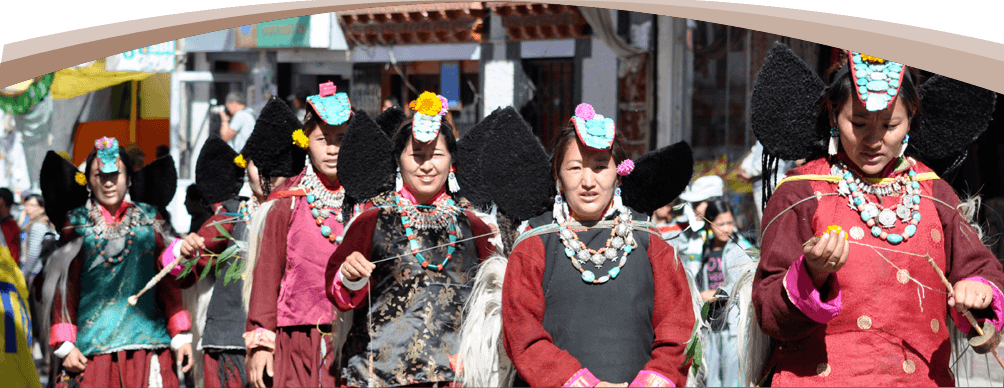| Culture Tour |
| |
Ladakh"land of high passes is a region of India in the state of Jammu and Kashmir and inhabited by people of Indo-Aryan and Tibetan descent.
Cuisine
Ladakhi food has much in common with Tibetan food, the most prominent foods being thukpa (noodle soup) and tsampa, (roasted barley flour). dish that is strictly Ladakhi is skyu, a heavy pasta dish with root vegetables.. As in other parts of Central Asia, tea in Ladakh is traditionally made with strong green tea, butter, and salt. It is mixed in a large churn and known as gurgur cha, most of the surplus barley that is produced is fermented into chang, an alcoholic beverage drunk especially on festive occasions
Architecture
The architecture of Ladakh contains Tibetan and Indian influences and monastic architecture reflects a deeply Buddhist approach. The Buddhist wheel, along with two dragons, is a common feature on every gompa, Many houses and monasteries are built on elevated, sunny sites facing south, and in the past were made of rocks, earth and wood but are now more often concrete frames filled in with stones or adobes.
Music and dance
Traditional music includes the instruments surna and daman, The music of Ladakhi Buddhist monastic festivals, like Tibetan music, often involves religious chanting in Tibetan or Sanskrit as an integral part of the religion,Religious mask dances are an important part of Ladakh's cultural life. The dances typically narrate a story of the fight between good and evil, ending with the eventual victory of the former.
Wear
Weaving is an important part of traditional life inLadakh. Both women and men weave, on different looms. Typical costumes include gonchas of velvet, elaborately embroidered waistcoats and boots and hats.
The Ladakh Festival is held every year from September 1 to 15. Performers adorned with gold and silver ornaments and turquoise headgear throng the streets. Monks wear colourful masks and dance to the rhythm of cymbals, flutes and trumpets. The yak, lion and Tashispa dances depict the many legends and fables of Ladakh
Sports
The most popular sport in Ladakh now is ice hockey, which is played only on natural ice generally mid-December through mid-February.Archery is a traditional sport in Ladakhaccompaniment of the music of surna ,
Polo, the other traditional sport of Ladakh is indigenous to Baltistan and Gilgit, and was probably introduced into Ladakh in the mid-17th century by King SinggeNamgyal, whose mother was a Balti princess.
Traditional medicine
Tibetan medicine has been the traditional health system of Ladakh for over a thousand years. This school of traditional healing contains elements of Ayurveda and Chinese medicine, combined with the philosophy and cosmology of Tibetan Buddhism. For centuries, the only medical system which was accessible to the people have been the amchi who are traditional doctors following the Tibetan medical tradition. Amchi medicine is still an important component of public health to this day, especially in remote areas.
.
|
| Trip Schedule: |
| |
- Day 1 arrived lehfullday rest at hotel,
- Day 2 Shanti stupa, Leh Palace, and Leh market,
- Day 3 Shey ,Thiksay, Hemis,
- Day 4 LehSpituk, magnetic Hill,Alchi,
- Day 5 alchilamayuruleh,
- Day 6 LehNubra
- Day 7 NubraLeh,
- Day 8 Tsomoririlake,
- Day 9Tsomorir Leh
- Day 10 LehPangong Lake,
|
| |
| Trip Highlights: |
| Exploring the 1000 year old murals of AlchiChoskor, the ancient LamayuruMonaster, the Monastery enshrines of the most revered statues of Avalokiteshwara, White Sand Dunes between Diskit&Hunder. Khardongla pass 5620 meters, and beautiful high altitude lakes, among others. |
| |
Trip Details:-
August to October is the best time to visit |
| |
|

